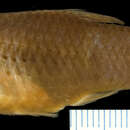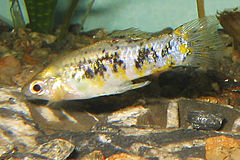fr
noms dans le fil d’Ariane


Limia vittata és una espècie de peix de la família dels pecílids i de l'ordre dels ciprinodontiformes.[2]
Els mascles poden assolir els 8 cm de longitud total i les femelles els 10.[3]
Limia vittata és una espècie de peix de la família dels pecílids i de l'ordre dels ciprinodontiformes.
The Cuban limia (Limia vittata), also known as banded limia, Cuban molly, Cuban topminnow or tabai is a species of livebearing freshwater fish from the family Poeciliidae. The species is native to Cuba where it was endemic but it has been introduced to Hawaii.
The Cuban limia is olive-green in background colour[3] and has a bluish-grey back, silvery flanks marked with black-edged scales and a white belly. There is a yellow patch close to the vent in fenmles. In the males have the dorsal fin and the anal fin are normally yellow-orange in colour marked with blue-black spots. The females have colorless fins which are marked with a few scattered, black freckles.[4] The females grow to over twice the size of the males which can have a total length of 5 centimetres (2.0 in), and females reach 10 centimetres (3.9 in).[2] In structure it is a rather robust species, depressed towards the rear with a rounded tail and it has a compressed head which has a small, oblique mouth with a protruding lower jaw and a protractile upper jaw.[3]
The Cuban limia is, as the common name suggests, native to Cuba. It occurs throughout the island of Cuba and the neighbouring Isla de la Juventud.[5] It has been introduced to Hawaii, where it is found on the islands of Oahu and Hawaii, where it is found in the Kaloko-Honokōhau National Historical Park.[6]
Within its native range the Cuban limia inhabits streams, lakes, estuaries, coastal lagoons, and mangrove swamps[6] and can be found in both freshwater and brackish water,[2] or saline water.[4] Its diet consists of worms, crustaceans, insects and plant material. It often forms mixed shoals with species such as sailfin mollies and mosquitofish.[6] A larger female may give birth to up to 50 fry at a time and in a 4-6 week period can produce up to 100 young.[6]
This species is present in the aquarium trade and a number of colour variations have been bred.[7] It is thought that released aquarium fish are the origin of the population in Hawaii where they have been blamed for impacting the population of native damselflies.[4] In Hawaii it has been given the local name tabai.[2]
The Cuban limia was described by the French zoologist Alphone Guichenot in 1853 as Poecilia vittata.[1] A year later the Cuban zoologist Felipe Poey described a fish he named Limia cubensis and designated this as the type species of the genus Limia.[8] This was a synonym of Guichenot's Poecilia vittata and so L. vittata was considered the valid name.[2]
The Cuban limia (Limia vittata), also known as banded limia, Cuban molly, Cuban topminnow or tabai is a species of livebearing freshwater fish from the family Poeciliidae. The species is native to Cuba where it was endemic but it has been introduced to Hawaii.
Limia vittata es una especie de peces de la familia de los pecílidos en el orden de los ciprinodontiformes.[2][3]
Los machos pueden alcanzar los 8 cm de longitud total y las hembras los 10 cm.[4]
Se encuentran en América: Es un pez endémico de Cuba. Puede ser encontrado en la mayoría de ríos y arroyos del país, incluyendo aguas de alta salinidad como desembocaduras al mar y lagunas costeras.[4]
Limia vittata es una especie de peces de la familia de los pecílidos en el orden de los ciprinodontiformes.
Limia vittata Limia generoko animalia da. Arrainen barruko Poeciliidae familian sailkatzen da.
Limia vittata Limia generoko animalia da. Arrainen barruko Poeciliidae familian sailkatzen da.
Limia vittata is een straalvinnige vissensoort uit de familie van levendbarende tandkarpers (Poeciliidae).[1] De wetenschappelijke naam van de soort is voor het eerst geldig gepubliceerd in 1853 door Guichenot.
Bronnen, noten en/of referenties Systematyka Domena eukarionty Królestwo zwierzęta Typ strunowce Podtyp kręgowce Gromada promieniopłetwe Infragromada doskonałokostne Rząd karpieńcokształtne Rodzina piękniczkowate Podrodzina Poeciliinae Rodzaj Limia Gatunek limka pręgowana Synonimy
Systematyka Domena eukarionty Królestwo zwierzęta Typ strunowce Podtyp kręgowce Gromada promieniopłetwe Infragromada doskonałokostne Rząd karpieńcokształtne Rodzina piękniczkowate Podrodzina Poeciliinae Rodzaj Limia Gatunek limka pręgowana Synonimy Limka pręgowana[2], limka kubańska[3] (Limia vittata) – gatunek ryby z rodziny piękniczkowatych (Poeciliidae). Bywa hodowana w akwariach.
Limka pręgowana żyje w wodach Kuby.
Żywi się każdym rodzajem pokarmu, w skład jej diety wchodzą składniki roślinne.
Akwarium powinno być duże, z wolną strefę do pływania oraz kępy roślinności i glonów. Woda powinna być średnio twarda, dobrze filtrowana. Do wody można dodawać łyżeczkę soli na 4,5 l. Temperatura wody wynosi ok. 26 °C.
Limka pręgowana, limka kubańska (Limia vittata) – gatunek ryby z rodziny piękniczkowatych (Poeciliidae). Bywa hodowana w akwariach.
古巴泥鱂,為輻鰭魚綱鯉齒目鯉齒亞目花鳉科的其中一種,分布於中美洲古巴的淡水、半鹹水流域,體長可達8公分,棲息在溪流、湖泊、潟湖、紅樹林,屬肉食性,以甲殼類、蠕蟲、昆蟲等為食,可作為觀賞魚。